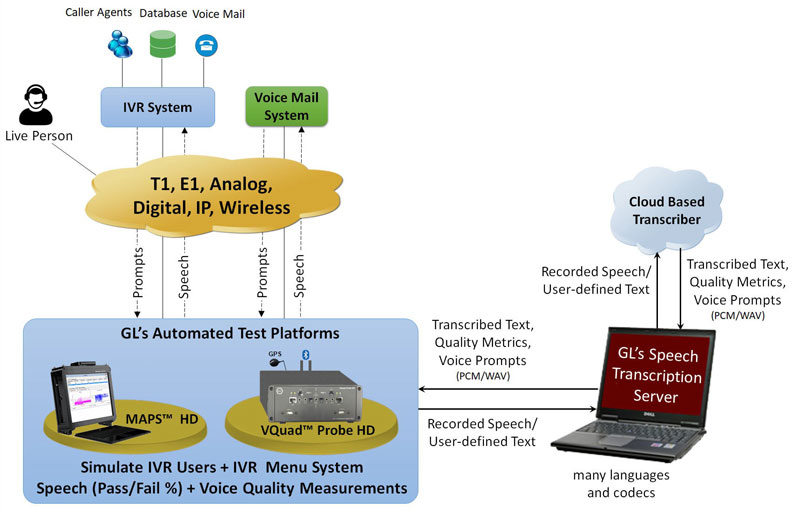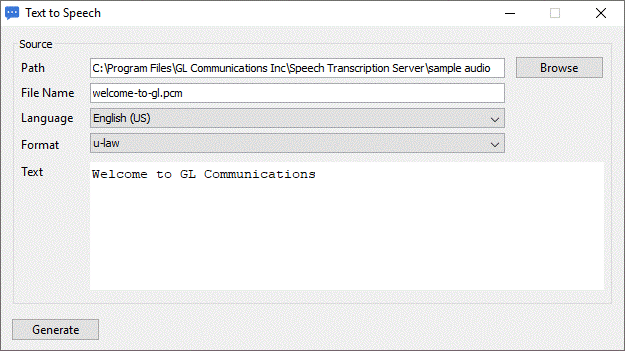Speech Synthesis to Test Interactive
Voice Response (IVR) and Voice Mail (VM) Systems
28th, Jul 2019
Welcome to another June 2019 issue of GL Communication’s Newsletter providing information and insight into our new speech-to-text conversion utility referred to as Speech Transcription Server, which is enhanced with text-to-speech feature that allowing automated on-the-fly generation of audio files from user-defined text.

Overview
GL’s Speech Transcription Server (STS) is an automated PC-based speech-to-text conversion utility which is enhanced with text-to-speech allowing automated on-the-fly generation of audio files from user-defined text required for voice responses in IVR systems.
The Cloud-based speech synthesizer converts text into human-like speech in more than 50 languages and variants saved in PCM or WAV audio file formats.
As an easy-to-use API, Cloud-based speech synthesizer is a flexible solution for creating a variety of use cases. Common use cases include call center automation, testing Interactive Voice Response (IVR) and Voice Mail (VM) systems, transforming text to be consumed as audio, lifelike interactions across devices or applications including speech prompts to activate and control iPhone SIRI or Android Google assistant.
This can be used as a standalone utility or integrated with other GL test tools for automation, precise call control, and quality analysis. STS supports REST APIs which allows the utility to be used with any GL intrusive test tool including MAPS™ and VQuad™. One can send and receive transcription requests, as well as retrieve transcription results from the database.
MAPS™ provides a unique architecture for multi-interface, multi-protocol simulation, which makes it suitable for testing any core network, access network and inter-operability functions. VQuad™ Probe HD is an all-in-one self-contained hardware solution supporting multiple physical interfaces for connecting to practically any wired or wireless network while automatically performing end-to-end voice and data testing over any network.
GL’s MAPS™ and VQuad™ emulator platforms can work in conjunction with Speech Synthesizer to automate IVR tree traversal testing where voice responses are required. Generate expected voice prompts (IVR menus) from the user defined text saved in pcm/wav file format and in various languages. Both MAPS™ and VQuad™ testing platforms allow usage of Speech Synthesizer over various networks such as 2-wire (FXO, FXS), TDM, IP, and Wireless (GSM, UMTS, VoLTE, ...).
The utility includes settings to configure the languages (more than 50 languages are supported) and audio file format (pcm/wav). The text can be manually entered to generate the required voice prompts accordingly. The converted audio files are automatically saved in the customized directory path.

Manual Generation of Audio Files from User-defined Text
Speech Synthesizer with VQuad™
GL’s VQuad™ solution works in conjunction with the Speech Synthesizer to fully automate Mobile Phone Testing using Bluetooth®/wired headset interfaces. The Wired headset method connects the mobile phone to the Dual UTA HD using the GL Smartphone Automated Call Control (ACC) cable.
Mobile devices connected to VQuad™ via Dual UTA Bluetooth/ACC interface can be controlled through the VQuad™ scripts (or manual operation). VQuad™ can activate the iPhone SIRI or Android Google Voice and send voice commands to the mobile device in order to perform various functions such as Placing Call, Answering calls, Rejecting calls, Disconnect calls and Sending Messages (SMS) (or any command available through SIRI or Google Voice). The voice prompts created using text-to-speech synthesizer are used to activate and to perform call control functions over Siri or Google Voice.
By invoking Siri/Google Assistant it is also possible to setup calls over VoIP applications (Over-the-TOP applications) such as Skype, WhatsApp, Viber installed on iPhone devices and using Hangout app on Android devices. It is also possible to send text messages through these applications using voice commands generated using Text-to-Speech conversion facility.
Similarly, it is also possible to invoke GL applications (GLNetTest) installed on the mobile devices and perform Data and Voice tests.

Speech to Text using Manual Mode with speech analysis
The testing can be automated directly from the VQuad™ scripting using the dynamically created voice files.
Speech Synthesizer with MAPS™ IVR
Users can leverage GL’s MAPS™ platforms to automate testing of any IVR system. MAPS™ provides the necessary base to emulate different IVR call flows and user profiles with complete automation. MAPS™ can be configured to respond to the requests received from IVR system (DUT), using the voice prompts pcm/wav files generated from the speech synthesizer utility. MAPS™ allows transmission and recording of voice audio files generated over any telecommunication network interface such as FXO/FXS, 4-Wire, ISDN, SS7, GSM, UMTS, and VoLTE, and can be controlled/automated via scripting and API.
Besides IVR testing it can also be applied to any announcement verification and voicemail testing, Answering machine messages, Phone prompts for a menu system, where the expected voice prompts are generated from the user-defined text.

IVR Testing of GL's phone system using MAPS™ APS and Speech Synthesizer
Main Features
- Ability to convert text files into PCM (u-law, PCM16 16 kHz, PCM16 24 kHz) or WAV (u-law, a-law, WAV16 16 kHz, WAV16 24 kHz) speech file formats
- Supports multi-languages such as U.S/U.K/India/Australia/Canada/Ireland English, French, German, Italian, Japanese, Chinese, Portuguese, Russian, Spanish and many more
- Cloud-based speech synthesizer provides accurate speech files (Requires Internet connectivity)
- Instantaneous voice prompt generation for the user defined text
- Assist with IVR testing where voice responses are required
- Support for Windows® 7 and above
Benefits
- Out-of-the box integration support with existing GL test platforms such as VQuad™ and MAPS™
- REST API support for fast and easy integration with third party testing platforms
- REST API server allows one Speech Transcription Server instance to serve multiple clients
- Generate necessary voice prompts to activate iPhone Siri and Google Voice and automate call control test functions on connected mobile devices.
- User defined text allows to generate expected voice prompts while testing IVR systems
 Back to Newsletter Index Page
Back to Newsletter Index Page